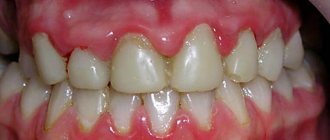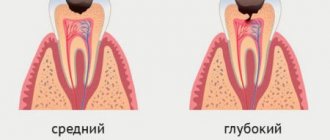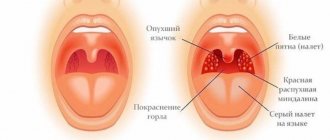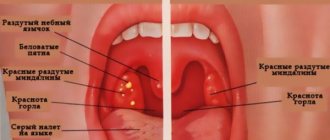Swelling of the throat - what is it?
People of all ages can experience an extremely dangerous condition, symptomatically described as swelling of the throat. This secondary pathology (not an independent disease) is expressed in a narrowing of the lumen of the larynx and indicates the development of diseases of various origins or injury to the organ. Swelling of the throat, the causes of which are inflammatory or non-inflammatory in nature, according to the nature of the course can be:
- lightning - manifests itself in cases of injury to nearby tissues or allergies; the clinical picture is formed within a few minutes;
- acute - accompanies inflammatory processes and infectious diseases; temporary establishment of a full-scale clinic takes up to several hours;
- chronic - detected in the event of neoplasms (benign or malignant); Full development of clinical manifestations requires from several days to several weeks.
Sore throat is a type of acute inflammation of the tonsils (the same ones that are colloquially called “tonsils”). ... Such increased attention to one single form of tonsillitis is due to the fact that angina is often very severe and gives dangerous complications (including fatal ones!).
Symptoms and treatment of sore throat in children have certain specifics. The course of the disease in older children is accompanied by weakness and drowsiness, while in younger children, on the contrary, one may notice manifestations of anxiety and irritability. Enteroviral tonsillitis in children is accompanied by the appearance of a vesicular rash with liquid inside on the mucous membranes of the tonsils, arches and pharynx. When the blisters burst, ulcers with a white coating appear. There are no scars left after they heal.
Sore throat in children under five years of age is dangerous because a dangerous condition such as false croup can develop. In this case, swelling of the larynx is observed, its lumen narrows, resulting in a clinic of suffocation. If a child has breathing problems, you need to call an ambulance immediately, and before it arrives, ensure access to fresh air in every possible way, for example, take the baby out to the balcony or simply open a window.
For angina, it is necessary to use antiviral drugs (prescribed by a pediatrician).
Treatment of viral sore throat in children should include measures to cleanse toxins.
You should not give your child aspirin or alcohol tinctures. Gargles are usually done if the child is over 4 years old. A young child usually cannot hold his breath and simply drinks the rinse.
Antibiotics for viral tonsillitis are prescribed to children much less often than to adults, that is, only in extreme cases.
Types of sore throat
There are no significant differences in the classification of the disease in children and adults. The disease can be catarrhal, lacunar, follicular, necrotic. The mildest is catarrhal, and the most severe is necrotic.
Catarrhal tonsillitis - superficial damage to the tonsils and moderate signs of intoxication, temperature up to 38 degrees, changes in the blood are minor. When examining the throat, bright hyperemia is detected, covering the back wall of the pharynx, hard and soft palate. The tonsils enlarge mainly due to swelling and infiltration.
Lacunar and follicular tonsillitis. These types of sore throat have similar symptoms and often develop simultaneously: accompanied by a temperature of up to 39-40 degrees, signs of intoxication are clearly expressed
Fibrinous tonsillitis - characterized by the presence of a whitish-yellow fibrinous plaque on the tonsils, regional lymphadenitis is observed. It is necessary to note the following feature of this type of sore throat - it occurs more often in children with severely weakened immunity. This disease can be the result of lacunar tonsillitis or develop independently.
Phlegmonous tonsillitis is a purulent melting of the tonsil area. People between the ages of 15 and 40 are mainly affected. The tonsil is hyperemic, enlarged, and painful on palpation. The throat hurts severely when talking and swallowing, and signs of intoxication are clearly visible. The patient's temperature rises to an alarming level of 39-40 degrees.
Necrotizing tonsillitis. In this case, general and local symptoms are more pronounced than in the forms described above. The patient has a persistent fever, signs of confusion, and constant vomiting. A plaque with a pitted surface is found on the tonsils. Its color can be grayish or greenish-yellow. The affected areas are often saturated with fibrin, that is, they become dense.
How is angina transmitted?
Pathogenic microorganisms live in the tonsils of every person, including absolutely healthy ones, usually without manifesting themselves in any way. But if any provoking factors arise, the pathogenic microflora is activated, as a result of which the tonsils become inflamed and a sore throat develops.
Typically, the peak incidence occurs in the winter and off-season, when people cough and sneeze especially often. This is due to the fact that sore throat is transmitted by airborne droplets.
You can become infected from a person through a kiss or sharing personal hygiene items.
Prevention of sore throat
Prevention of angina is aimed at overall strengthening of the body and eliminating various infections that provoke the disease. It requires an integrated approach:
· Maintaining personal hygiene. During illness, the patient must use a separate towel, toiletries and utensils.
· If you have a sore throat, the patient should be isolated from other family members and people. The room should be cleaned regularly.
· Support proper nutrition. It should be healthy, nutritious, contain vitamins and minerals.
· Regular examination and treatment of helminthiasis, as well as all sources of chronic infection: caries, pyelonephritis, sinusitis, chronic tonsillitis, various purulent skin diseases. Maintain oral hygiene and get examined by a dentist. If necessary, carry out partial or complete removal of adenoids or tonsils.
· Hardening a child from an early age. It is best to start hardening in childhood, but it can be done at any age. Among the methods of hardening are dousing, rubbing, contrast showers, swimming, walking barefoot on stones and sand. The process should be gradual so that the body gets used to the stress. Hardening can only be carried out in a healthy state.
· Increased immunity level. It is necessary to protect the mucous membranes from damage with dry and warm air. Do not frequently use local antiseptics in the form of sprays. Cold drinks and foods can be consumed only in small quantities so that the mucous membranes get used to low temperatures. It is necessary to increase the body's defenses. To do this, you can make an appointment with an immunologist who will prescribe medications that stimulate cellular and humoral immunity, immunomodulators of bacterial origin, and a complex of vitamins.
For this disease, therapy must be comprehensive. Its basis is complete rest in bed rest. Even with proper medical treatment without bed rest, viral tonsillitis can cause complications that will require much more radical and expensive methods of intervention.
As for nutrition, it is better to avoid heavy and sweet foods during illness. Some of them irritate the throat, their digestion requires additional strength from the body, in addition, sugar creates a very comfortable environment for pathogenic bacteria. While the sore throat caused by the virus lasts, it is better to focus on fresh fruits.
Drinking plenty of fluids will help the body cope with the infection much faster. In this case, toxins will be excreted along with urine. While the symptoms characterizing viral tonsillitis are present, it is better to drink warm homemade berry fruit drinks rich in vitamin C. A variety of jelly is also suitable - they soften the throat and soothe pain. During this period, it is better to drink tea with honey and lemon, and you should avoid coffee (it increases nervous activity).
To gargle, you can use decoctions and infusions of various herbs, in particular sage, chamomile, mint, and plantain. A saline solution with iodine is often used. It is advisable to start rinsing on the first day of symptoms.
In some cases, inhalations can lead to a speedy recovery of the patient and eliminate the infection from the body. Raspberry fruits, thyme tincture, eucalyptus oil are very effective for purulent sore throat without fever. You can also use the old grandfather’s method - “breathe over the potatoes.” To do this, bring the washed potatoes to a boil and add a couple of drops of cinnamon oil. Then you should carefully inhale the steam for 15 minutes. Include both your nose and mouth in this process.
Regular gargling can remove the infection from the body as quickly as possible and reduce pain. In this matter, the main thing is to maintain stability.
Antihistamines and anti-inflammatory drugs are prescribed to reduce swelling and soreness in the throat, as well as to alleviate general toxic effects.
Some forms of tonsillitis require surgery, as the patient may suffocate or the infection spreads to other organs. In this case, complete or partial removal of the affected tonsils and pus is performed. The patient is recovering in hospital. After surgery, it is necessary to limit physical activity, protect yourself from hypothermia, and strengthen your immune system and health.
Swelling of the throat with sore throat
International medical practice classifies inflammation of the tonsils as acute tonsillitis. However, the more familiar name for us “angina” (translated from Latin means “squeeze, strangle”), quite accurately describes the ongoing pathological process. Swelling of the throat during sore throat partially blocks the airways, and the patient begins to choke. This rather serious local complication is accompanied by:
- stridor (difficulty noisy breathing);
- pain when swallowing in the absence of cough;
- swelling of the neck, change in color of the skin of the face (pallor, and then cyanosis).
Types of edema.
There are several types of Quincke's edema.
Angioedema can be hereditary or acquired. Hereditary angioedema is a rare genetic disease that was first described at the end of the 19th century and is characterized by recurrent edema. If a mother or father has this diagnosis, the probability that their child will be born with the same diagnosis is 50%. With timely prevention and proper treatment, the patient’s attacks rarely occur, and the patient lives quite well with this diagnosis. Cases of acquired disease are quite small, and are most often observed in elderly patients.
Depending on the cause that caused Quincke's edema, allergic, non-allergic and idiopathic edema are distinguished when the cause of the condition could not be determined.
Swelling of the throat due to a cold
One of the symptoms accompanying colds is swelling of the larynx. Swelling of the throat during a cold manifests itself:
- sore throat, pain when swallowing;
- dry cough, change in voice timbre up to aphonia (complete loss of voice);
- difficulty breathing.
The severity of the clinical picture depends on the disease and the individual reactivity of the patient’s body. For example, with false croup, swelling of the throat in a child can be complicated by laryngeal stenosis.
Who to contact
If laryngeal edema develops in a child, treatment is prescribed by the pediatrician based on the results of the examination. In difficult cases, based on the results of the examination, the pediatrician may refer you to an otolaryngologist (ENT), an infectious disease immunologist, or an allergist.
The pediatric department of JSC "Medicine" (clinic of academician Roitberg) offers the services of qualified experienced specialists working in various fields of medicine.
You can make an appointment with a pediatrician on the website page. Our clinic is located in the center of Moscow at 2nd Tverskoy-Yamskaya lane, 10, a five-minute walk from the Mayakovskaya metro station.
Allergic swelling of the throat
Severe development is characterized by swelling of the throat due to allergies. Many substances and agents can act as allergens - dust, insect bites, animal hair, some medications, foods, etc. Allergic swelling of the throat is expressed by specific signs in addition to the main symptoms:
- nasal congestion and discharge (rhinitis);
- bronchospasm;
- diarrhea and skin rashes;
- lacrimation.
A particularly dangerous form of allergic swelling of the throat is Quincke's edema.
How to relieve throat swelling at home?
It must be remembered that at the first symptoms of throat swelling, urgent medical attention is needed. The likelihood of rapid development of the condition requires emergency medical intervention to save the patient’s life. In such a situation, the problem of how to relieve throat swelling at home comes down to providing emergency assistance before the ambulance arrives:
- try to calm the patient, as a panic state increases swelling;
- try to provide access to air (unbutton your collar, remove your tie, if possible, increase the humidity of the room);
- if there is absolute confidence in the allergic nature of the swelling of the throat, then give the patient an antihistamine.
How to make an appointment with a doctor
To receive highly qualified medical care, you must make an appointment with a pediatrician who will conduct an examination and comprehensive medical examination of the child. If necessary, the pediatrician will consult with or refer other specialists.
To make an appointment with a specialist in the pediatric department of JSC "Medicine" (clinic of academician Roitberg), use one of the following methods:
- a quick entry form on the main page of the center’s website;
- by telephone 24/7;
- using a mobile application.
The clinic of JSC "Medicine" (clinic of academician Roitberg) is located in the center of Moscow at 2nd Tverskoy-Yamskaya lane, 10, a five-minute walk from the Mayakovskaya metro station, as well as not far from the Belorusskaya, Tverskaya, Chekhovskaya and Novoslobodskaya metro stations .










